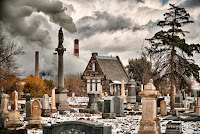Deep Mapping: Kettle Bottom, Marked Men, and Digging Deep with Leslie Ullman
 |
| Turning Point Books |
Joseph Hutchison “deep maps” this very land in his
historic narrative poem "Marked Men" about
the Sand Creek Massacre.
“A dream led me to the end of the poem,” he told the Tattered
Cover audience at his recent signing, “and a dream began the poem. I woke up one night and Chivington was
standing at the end of my bed—not saying anything—just looking down at me. But Chivington didn’t interest me. I started writing about my responsiveness to
the dream. And in the dream there was a
cemetery…”
 | |
| John E. Poplin's Denver Cemeteries |
 I expected to learn none of this when I sat down to
listen to Joseph Hutchison read from Marked Men, though it was Linda Hogan’s endorsement that drew me there. “Marked
Men is a book where truth finally catches up with history… Read it, and
remember the stories in this land, still walking on our streets, and still
alive.”
I expected to learn none of this when I sat down to
listen to Joseph Hutchison read from Marked Men, though it was Linda Hogan’s endorsement that drew me there. “Marked
Men is a book where truth finally catches up with history… Read it, and
remember the stories in this land, still walking on our streets, and still
alive.”  To read the work of a good poet is to hold in the palm of
your heart a chunk of humanity, laid bare and pulsing, each word like the
sudden intake of breath—sharp, visceral, urgent—especially when the poems unearth
a deeper truth beneath the layers of asphalt upon which we stand.
To read the work of a good poet is to hold in the palm of
your heart a chunk of humanity, laid bare and pulsing, each word like the
sudden intake of breath—sharp, visceral, urgent—especially when the poems unearth
a deeper truth beneath the layers of asphalt upon which we stand.
In a landscape far to the east of Denver, poet Diane Gilliam Fisher, this year’s winner of AROHO’s $50,000 Gift of Freedom Award
for her collection Kettle Bottom (Perugia
Press 2004), knows how make “the
stone of the West Virginia mountains yield up its human past….”
Fisher writes of the coal camps, and of the lives birthed
and buried there. These lines are excerpted from her poem “David.”
Papa…goes every day
into the mountain, into the
stone. It seals
him in. Sealed in, the men from the company
they tell Mamma the roof it
fell, they are sorry.
The poem ends:
….No Michelangelo
here to cut the stone away from
the beautiful men.
I read Kettle Bottom from cover to cover, nearly in one sitting. And when I turned the
last page, read the last line, closed the cover quietly—a deep breath came out of me, a slow drawling exhale filled
with a deeper reckoning of the death and hardship of those West Virginia coal
mining folks. Delsey Salyer. Maude Stanley. Hazel. Clayton. Shelva Jean.
Miss Terry. Pearlie Webb. The poor Dago boy.
When authors “deep map” a small corner of the earth - in our poems, or novels, or memoirs - we
travel vertically through time - down through the history that layers the land, beneath
the asphalt and before the botanic gardens, down to where the bones and the
stories lie waiting. It’s not a journey
for the faint of heart, but I guarantee you’ll rise up from the experience hungry
for oxygen and eager to write.
MORE ON DIGGING DEEP: I’m halfway through Leslie Ullman’s new and remarkable, fourth collection Progress on the Subject of Immensity (University of New Mexico Press, 2013). In her poem “The Story I Need” (first published in Cerise Press), Leslie—in barely 7 exquisite stanzas—conveys this entire 700-word essay of mine. Ah, to be such a fine poet! Read entire poem. Leslie teaches in the low-residency MFA Writing Program at Vermont College of Fine Arts.
NOTE: To learn more about "deep mapping," contact Page for a helpful workshop handout.






Comments